React
January 07, 2019monorepo
https://itnext.io/guide-react-app-monorepo-with-lerna-d932afb2e875
create react app
create-react-app my-app --typescript
with lerna
lerna add @types/jest
lerna add @types/node
lerna add @types/react
lerna add @types/react-dom
lerna add react
lerna add react-dom
lerna add react-scripts
lerna add typescript
lerna add tslint
Performance
Context
The way that context works is that whenever the provided value changes from one render to another, it triggers a re-render of all the consuming components (which will re-render whether or not they're memoized).
When:
- Your context value changes frequently
- Your context has many consumers
- You are bothering to use React.memo (because things are legit slow)
- You've actually measured things and you know it's slow and needs to be optimized
Tips:
- Slice context up when possible
- Use memo within context if needed
Large App State

-
Use HOC to handle memoization
Performance Monitoring
Async (Suspense)
- React renders components in try/catch, if you throw a promise during render if it's not ready it will update when ready
const pokemonPromise = fetchPokemon("pikachu").then(
(pokemonData) => (pokemon = pokemonData),
);
function PokemonInfo() {
if (!pokemon) {
throw pokemonPromise;
}
return (
<div>
<div className="pokemon-info__img-wrapper">
<img src={pokemon.image} alt={pokemon.name} />
</div>
<PokemonDataView pokemon={pokemon} />
</div>
);
}
Error Handling
if (pokemonError) {
throw pokemonError;
}
<ErrorBoundary>
<React.Suspense fallback={<div>loading...</div>}>Yo</React.Suspense>
</ErrorBoundary>;
Promises inside render
- Dangerous, don't assume render called only once
- Use a cache to resolve
const promiseCache = {};
function MySuspendingComponent({ value }) {
let resource = promiseCache[value];
if (!resource) {
resource = doAsyncThing(value);
promiseCache[value] = resource; // <-- this is very important
}
return <div>{resource.read()}</div>;
}
✅ ⚠️ ⛔
Fetch on Render (default)
✅ benefits from colocation ✅ fetch when component renders ⛔ User may see empty content ⛔ Takes time
Fetch than render
⛔ empty content
Render as fetch
✅ Fetch data and assets as soon as you have the assets you need (preload) ⚠️ Lose the benefits of colocation unless split into two files (data and component)